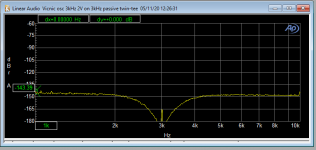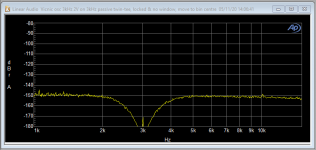I'm using mine with Win 10. There is a patch floating on the web to make it work. It seems to work fine except you need to manually start the application to control it. Not really bad if you don't always need it. The isolation really removes a lot of odd noises from the PC. Here are the directions: E-MU 1616m, 1212m, 1820m, 0404 Audio Interface - Complete Windows 10 (1903 & Above) Installation Guide - KVR Audio
Hi Demian,
Thank you for the link. I have no doubt I'll be forced into WIN10 at some point in time.
-Chris
Thank you for the link. I have no doubt I'll be forced into WIN10 at some point in time.
-Chris
I guess you meant 1820m 🙂. 1616m has only 6 in 6 out and 3 AK5394As.The EMU stuff is not easy to deal with but it has very good ADC's and a lot of flexibility. The 1616m is an external box that is well isolated from the PC with 8 in and 8 out using 4 AK5394A's. That makes it much more interesting.
Btw, no issues using my 1616m (PCIe version) on Windows 10 with modified drivers.
I purchased three emu 1616m's in the last few years. Sadly everyone lied from whom
I purchased them, including no "m", wrong interface card, and non working unit.
Yes, I got money back from fleaBay, but still....
Maybe some day.
I purchased them, including no "m", wrong interface card, and non working unit.
Yes, I got money back from fleaBay, but still....
Maybe some day.
Hi Sync,
You have to buy the ones that are priced right, not the cheapest ones available.
-Chris 🙂
You have to buy the ones that are priced right, not the cheapest ones available.
-Chris 🙂
This is stock from Viktor, no mods (except me adding a balanced output, but this is on the se output).
Jan
Jan
Next issue: trying to synchronize Viktors oscillator to a stable ref oscillator.
I have no clear picture where I should inject a locking signal, see attached Viktor's oscillator.
I haphazardly injected a signal that was a few Hz off the oscillator frequency at pin 2 of IC2, through a very large (0.5M) resistor, but all that does is cause a beat on the amplitude with the difference frequency ...
Any ideas?
Jan
I have no clear picture where I should inject a locking signal, see attached Viktor's oscillator.
I haphazardly injected a signal that was a few Hz off the oscillator frequency at pin 2 of IC2, through a very large (0.5M) resistor, but all that does is cause a beat on the amplitude with the difference frequency ...
Any ideas?
Jan
Attachments
My mistake, I should have injected it at pin 6 of IC2 of course. And then it works beautifully! Vic's oscillator, on itself, runs at around 3003.xx Hz, and drifts a few Hz from turn-on cold. With an injection of 3kHz at 200mV through 560k into pin 6, it snaps to exact 2999.99 Hz, rock-stable from the AP digital oscillator.
There is a fraction of a second re-stabilisation of the level when you turn the injection on or off, but the level returns to exactly the same in each case.
Distortion measurements give the same results as shown above, I don't see any harmonics above -148dBr or so.
The sweet spot seems to be between 150mV and 350mV injection through 560k, going too high starts 3rd harmonic to peek up, going too low shows a very low level 2nd and 3rd (-144dBr) until it looses lock.
Very nice - I now have a locked oscillator and can start to look into synchronous no-window FFT!
Jan
There is a fraction of a second re-stabilisation of the level when you turn the injection on or off, but the level returns to exactly the same in each case.
Distortion measurements give the same results as shown above, I don't see any harmonics above -148dBr or so.
The sweet spot seems to be between 150mV and 350mV injection through 560k, going too high starts 3rd harmonic to peek up, going too low shows a very low level 2nd and 3rd (-144dBr) until it looses lock.
Very nice - I now have a locked oscillator and can start to look into synchronous no-window FFT!
Jan
... and this is the result with a synchronized oscillator, no FFT window, move-to-bin-center.
Another milestone!
That is most impressive.
The look on your face when it locked and you got that result must've been priceless.
If I were you, I'd spend the rest of this year listening to music and reading books. I don't think you'll top this one easily.
Hi Jan,
Excellent performance and idea. I was wondering about trying this myself.
Next question. Does the distortion performance of the reference waveform affect the overall distortion? I'm curious if a DDS type generator can be left in place to absolutely lock the frequency without having to use something nearly as good (defeating the purpose).
Your work in this area has been valuable Jan.
-Chris
Excellent performance and idea. I was wondering about trying this myself.
Next question. Does the distortion performance of the reference waveform affect the overall distortion? I'm curious if a DDS type generator can be left in place to absolutely lock the frequency without having to use something nearly as good (defeating the purpose).
Your work in this area has been valuable Jan.
-Chris
Good question Chris. I initially used the AP analog generator, which gets at about -135dBr, and when that worked I switched to the digital DAC generator, which is rock stable as it is locked to the system clock, but has higher distortion, about -115 to -120 on a good day.
Both gave me the same result, so if there is an impact, it must be below the floor.
Another thing I found is that the wiring dress inside the case has a large impact. When opening it up and making some changes, I saw changes I could not explain, but could be remedied by slightly rearranging wiring.
As the say, at this level every atom matters ;-)
Jan
Both gave me the same result, so if there is an impact, it must be below the floor.
Another thing I found is that the wiring dress inside the case has a large impact. When opening it up and making some changes, I saw changes I could not explain, but could be remedied by slightly rearranging wiring.
As the say, at this level every atom matters ;-)
Jan
If you get a chance to use a higher distortion source, can you try that Jan? DDS generators are not the cleanest around.
I'm just looking for something that can cheaply control these while locked to the bench 10 MHz reference frequency.
-Chris
I'm just looking for something that can cheaply control these while locked to the bench 10 MHz reference frequency.
-Chris
Neat!
Can the future oscilators boards include a SMA connector on the PCB to serve this purpose?
Can the future oscilators boards include a SMA connector on the PCB to serve this purpose?
If you get a chance to use a higher distortion source, can you try that Jan? DDS generators are not the cleanest around.
I'm just looking for something that can cheaply control these while locked to the bench 10 MHz reference frequency.
-Chris
You can use the RTX6001, I think that is a DDS and relatively clean.
Jan
- Home
- Design & Build
- Equipment & Tools
- Low-distortion Audio-range Oscillator

